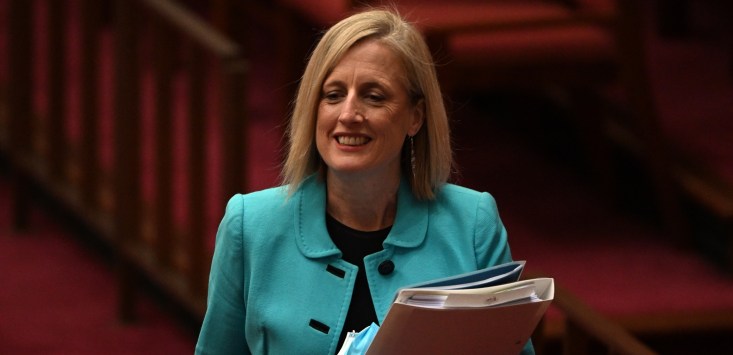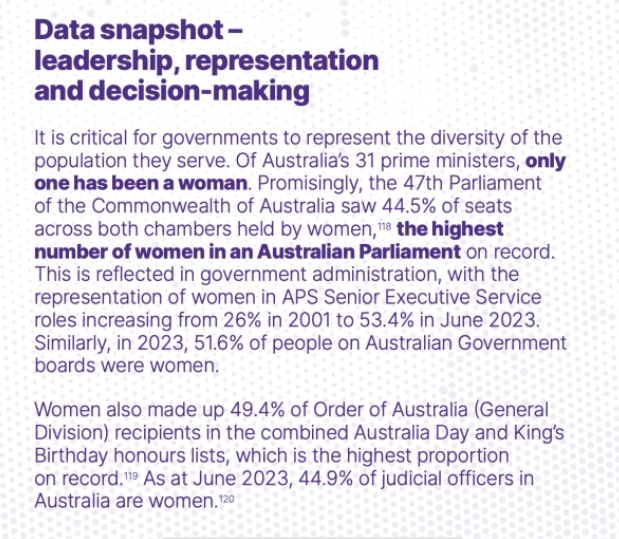
Minister for Women, Finance and the Public Service Katy Gallagher. Source: AAP Image/Mick Tsikas
A new five-year action plan under Labor’s national ‘Working for Women’ strategy offers a whole-of-government roadmap for gender equality. Getting more women from a range of backgrounds involved in decision-making is one major component.
The Women’s Economic Equality Taskforce’s (WEET) final report made it clear that a long-term, targeted and deliberate investment from the government was needed to ensure that women are leading and building the economy in equal measure to men.
Now, the government’s official strategy document, building on the work of the WEET, has affirmed its APS workforce must represent the population, as a key decision-maker, and has the power to role model the benefits of diversity in leadership.
“Leading by example is critical for the government, within parliament, Australian government boards, and the Australian Public Service,” the new ‘Working for Women’ strategy reads.
“Policy informed by the voices and lived experiences of diverse people ensures the government makes good decisions.”
Minister for Women, Finance and the Public Service Katy Gallagher launched the strategy, alongside Australia’s second ‘Status of Women’ report card, earlier this month.
Using the government workforce as a leader in driving gender equality is a key pillar of Gallagher’s plan, and the ways government employment arrangements as a national employer can support this goal continue to be expanded.
For example, APS data collection and target-setting towards gender equality goals are currently being implemented. Departments across the board are also lifting rates of flexible work arrangements, from 2027 APS parental leave (for both parents) is increasing to 18 weeks, and First Nations recruitment to Senior Executive Service levels has received renewed attention.
“The APS will ensure alignment between its work on gender equality with other diversity and inclusion strategies and policies to address the experiences of all APS employees who have faced discrimination and disadvantage in the workplace,” the strategy read.
“The Workplace Gender Equality Agency (WGEA) will continue to capture and use private and public sector employers’ gender equality performance data to provide best practice examples and support organisations.
“The government is committed to using this and other data from the APS to learn what drives gender inequality and what does or doesn’t work, so it can improve – drawing on the experience of the APS to not just improve how the public service drives change, but what can be done.”
In addition to four reforms already implemented or underway, Labor has promised to set targets for the number of women serving on government boards to eventually balance the number of women and men occupying chair positions at the individual board level.
The development of a new international gender equality strategy is also underway to show gender equality sits at the heart of Australia’s foreign policy, international development, humanitarian, trade and security efforts.
According to the team of policy experts in PM&C’s Office for Women who developed the strategy, extra work is needed to bridge ‘access gaps’ across the community when women are left out of decision-making.
“Given the unequal impact of crises like climate change and conflict on women, it is particularly critical women have a seat at the table in efforts to address these challenges,” the document read.
“To achieve gender equality, more women, including First Nations women and women from diverse backgrounds, need to be represented in decision-making and design, leadership and in public life.”
The strategy noted that women’s participation, opportunities and career progression in public spheres were often limited by forms of discrimination and prejudice.
Compounding these barriers to women’s representation in leadership and decision-making roles were more deterrents such as abuse and violence, including sexual violence and online abuse.
“Perceptions of women’s roles and capabilities, caring responsibilities and undervaluing the importance of lived experience in designing systems and policy responses contribute to [gender inequality],” the strategy authors explained.
“When women are not involved in decision-making and design processes, systems, policies, services, technology and infrastructure will not meet their needs.
“It can limit women’s access to resources and services, especially for women in rural and remote areas, women with disability, women living in poverty and women who do not have English as a first language.”
Writing in the foreword of the strategy document, Gallagher said that the goal was to outline a clear vision and concentrated effort for gender equality. Without this, she said the path to equality may still be another 50 years away.
“From where we stand in 2024, we still have a way to go before we can say that things are actually working for women in this country,” Gallagher said.
“Across the board, the same themes kept coming up — themes that aren’t new, but which reflect the enduring challenges that persist for so many women: that women just want to be safe – at home, at work, in the street; and that women don’t want to be crushed under the weight of juggling caring responsibilities and work, navigating complex systems and picking up the lion’s share of the load at home.
“Women want equal pay. And they want to retire with enough superannuation in their bank accounts to provide some economic independence. And they want government systems to work for and with them — not against them,” she said.
The decadal strategy includes an action plan for the next five years, indicators of change and measures to track the success over time.

Source: Working for Women Strategy 2024.
Leadership was one of five priority areas identified by the strategy that will guide the government’s response to gender equality in Australia: ending gender-based violence, unpaid and paid care, economic equality and security, health, representation and decision making.
“The strategy will have a mid-point review in 2029 where progress, focus and further action will be considered. This recognises that, while this strategy starts with a set of priorities that are most pressing to address first, further opportunities to drive progress will emerge over the life of the strategy and may become a focus for future effort,” the document read.
“Annual reporting mechanisms, alongside the periodic reviews will track progress and report government’s investments and efforts to drive progress towards the strategy’s ambitions and vision.”
The strategy’s reporting framework noted that monitoring and measuring progress would be facilitated by tools like the annual ‘Status of Women’ report card, women’s Budget statement, and departmental annual reports. Other periodic reporting tools that will be used include a one-year baseline data report, a five-year mid-point review, and a 10-year strategy end-point review.
‘Working for Women’ builds on the recommendations of the WEET. It also complements other national policies on women’s safety and health, led through the plan to end violence against women and children 2022–2032 and the women’s health strategy 2020–2030.
The strategy will also engage with equivalent gender equality plans at the state and territory government levels.
“This isn’t a strategy that outlines every single policy solution — but it does set out a clear commitment from the Albanese government to work for women,” Gallagher said.
“These priorities have, and will continue to, inform the work we do.”
This article was first published by The Mandarin.
Handpicked for you

“Vast discrimination and disadvantage”: Pregnant women and new mothers report dismal working conditions



COMMENTS
SmartCompany is committed to hosting lively discussions. Help us keep the conversation useful, interesting and welcoming. We aim to publish comments quickly in the interest of promoting robust conversation, but we’re a small team and we deploy filters to protect against legal risk. Occasionally your comment may be held up while it is being reviewed, but we’re working as fast as we can to keep the conversation rolling.
The SmartCompany comment section is members-only content. Please subscribe to leave a comment.
The SmartCompany comment section is members-only content. Please login to leave a comment.